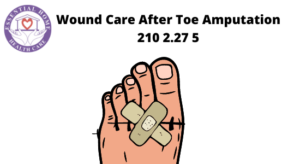You can do in-home wound care after toe surgery, but sometimes it can be tricky, so most people prefer to stay at the hospital. For quick recovery after toe surgery, you must take the utmost care.
You underwent toe amputation surgery to remove one or more toes. For the majority of people, the discomfort subsides within a week of surgery. Stitches or sutures may be present. These will most likely be removed about ten days after surgery. For approximately 2 to 4 weeks, you may be required to wear a cast or a particular type of shoe.

You may believe you have sensation or pain in the area where your toe was. This is referred to as phantom pain. It is quite common, and it may last a year or longer. If you are experiencing this type of discomfort, your doctor may prescribe medication to alleviate it. However, each individual recovers at a different rate. Take the steps outlined below to improve your health as rapidly as possible.
How Are You Going to Take Care of Yourself at Home?
When you are exhausted, take a break. Sleeping sufficiently will aid in recovery. Adhere to your doctor’s recommendations regarding the amount of weight you can place on your foot and when you can resume your normal activities. If crutches were provided, use them as recommended. How to do wound care after toe amputation?.
If possible, walk each day. Begin by walking somewhat more than you did the previous day. Increase your walking distance gradually. Walking increases blood flow and aids in the prevention of blood clots.
When you walk, you may notice certain alterations in your equilibrium. Your equilibrium will gradually improve. When icing your foot or leg, or if you sit or lie down for the next three days, prop it up with a pillow. Maintain it slightly above the level of your heart.
This will aid in the reduction of edema:
- Inquire with your physician when you will be able to drive again after toe surgery
- Shower unless your doctor instructs you otherwise. Maintain a dry bandage. After removing the bandage, wash the area with warm water and soap. Dry the area with a towel.
- You will most likely need to take approximately four weeks off work or your typical schedule. The amount of time you need to take off is determined by the nature of your profession and your overall health. Diet
- You may continue to eat normally. If you have an upset stomach, begin with bland, low-fat items such as plain rice, broiled chicken, toast, and yogurt.
- Immediately following surgery, you may notice that your bowel movements are irregular. This is not unusual. Constipation and bowel movement straining should be avoided. You may choose to take a daily fiber supplement. After a couple of days, if you haven’t had a bowel movement, consult your doctor about using a moderate laxative. medicines.
- Your doctor will determine whether and when you can resume taking your medications. Additionally, you will receive instructions on how to take any new medications.
If you are currently taking aspirin or another blood thinner, consult your doctor to determine when and if you should resume use. Ascertain that you comprehend precisely what your doctor is requesting:
- Take pain medications precisely as prescribed.
- If your doctor has prescribed pain medication, take it exactly as prescribed.
- If you are not using prescription pain medication, consult your doctor about the possibility of using over-the-counter medication.
- Take antibiotics exactly as suggested by your doctor. Continue taking them even if you feel better. You must complete the entire course of antibiotics.
If you believe your pain medication is making you annoy:
- After meals, take your medication (unless your doctor has told you not to).
- Consult your physician about an alternative type of pain medication.
Aftercare for Incisions
After several days, your doctor will likely remove the bandages. Alternatively, your doctor may instruct you to remove your bandages at home. Avoid touching the surgical area. Maintain a dry environment.
Do not soak your foot until your doctor indicates that it is safe to do so. Follow-up care is critical to your health and safety. Make and keep all scheduled appointments, and contact your doctor or nurse call line if you have any concerns. Additionally, it’s a good idea to be aware of your test findings and to maintain a list of the medications you take.
When Should You Seek Assistance?
Anytime you believe you may require emergency care. For instance, call if:
- You became unconscious (lost consciousness).
- You experience sharp chest pain, get short of breath, or cough up blood.
- Contact your doctor or nurse contact line immediately or seek emergency medical treatment if you experience any of the following:
- You are experiencing persistent pain that does not improve despite the use of pain medication.
- You feel queasy or are unable to take fluids.
- Your stitches have come undone or your incision has opened.
You have symptoms consistent with a blood clot in your leg (referred to as deep vein thrombosis), including the following:
- Calf, back of the knee, thigh, or groin pain.
- Your leg may be red or swollen.
- You exhibit indications of infection, including the following:
- Pain, swelling, warmth, or redness are all increased.
- Streaks of red emanate from the incision.
- Drainage of pus from the wound.
- A high temperature.
- Your bandage bleeds through.
- Keep a watchful eye on your health and don’t hesitate to contact your doctor or nurse if you have any concerns.
You can search out the best specialist after doing the search and look for a wound specialist near me. You can also contact Essential home health care or call us for more information at (847) 813 6301.
